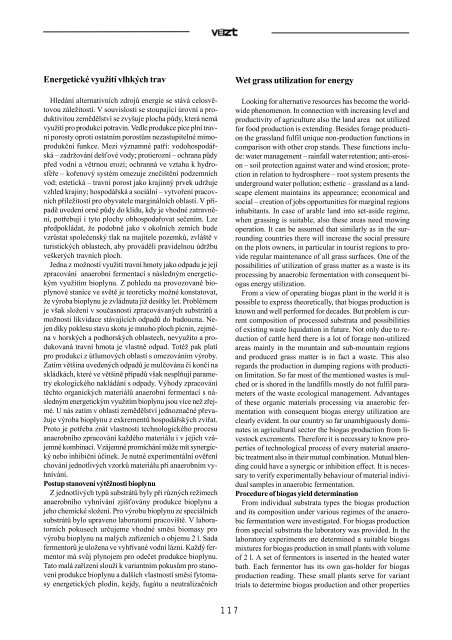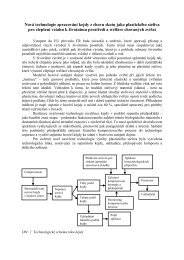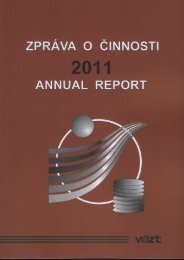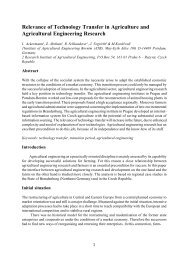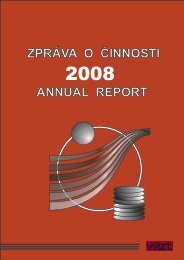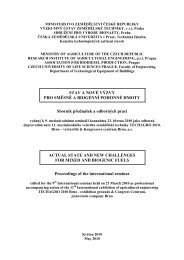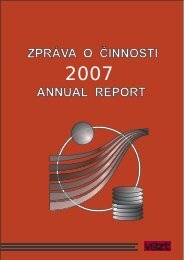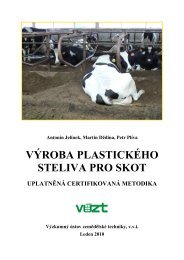Zpráva o ÄÂinnosti v roce 2006 (10MB) - SVT
Zpráva o ÄÂinnosti v roce 2006 (10MB) - SVT
Zpráva o ÄÂinnosti v roce 2006 (10MB) - SVT
You also want an ePaper? Increase the reach of your titles
YUMPU automatically turns print PDFs into web optimized ePapers that Google loves.
Energetické využití vlhkých trav<br />
Hledání alternativních zdrojù energie se stává celosvìtovou<br />
záležitostí. V souvislosti se stoupající úrovní a produktivitou<br />
zemìdìlství se zvyšuje plocha pùdy, která nemá<br />
využití pro produkci potravin. Vedle produkce píce plní travní<br />
porosty oproti ostatním porostùm nezastupitelné mimoprodukèní<br />
funkce. Mezi významné patøí: vodohospodáøská<br />
– zadržování deš ové vody; protierozní – ochrana pùdy<br />
pøed vodní a vìtrnou erozí; ochranná ve vztahu k hydrosféøe<br />
– koøenový systém omezuje zneèištìní podzemních<br />
vod; estetická – travní porost jako krajinný prvek udržuje<br />
vzhled krajiny; hospodáøská a sociální – vytvoøení pracovních<br />
pøíležitostí pro obyvatele marginálních oblastí. V pøípadì<br />
uvedení orné pùdy do klidu, kdy je vhodné zatravnìní,<br />
potøebují i tyto plochy obhospodaøovat seèením. Lze<br />
pøedpokládat, že podobnì jako v okolních zemích bude<br />
vzrùstat spoleèenský tlak na majitele pozemkù, zvláštì v<br />
turistických oblastech, aby provádìli pravidelnou údržbu<br />
veškerých travních ploch.<br />
Jedna z možností využití travní hmoty jako odpadu je její<br />
zpracování anaerobní fermentací s následným energetickým<br />
využitím bioplynu. Z pohledu na provozované bioplynové<br />
stanice ve svìtì je teoreticky možné konstatovat,<br />
že výroba bioplynu je zvládnuta již desítky let. Problémem<br />
je však složení v souèasnosti zpracovávaných substrátù a<br />
možnosti likvidace stávajících odpadù do budoucna. Nejen<br />
díky poklesu stavu skotu je mnoho ploch pícnin, zejména<br />
v horských a podhorských oblastech, nevyužito a produkovaná<br />
travní hmota je vlastnì odpad. Totéž pak platí<br />
pro produkci z útlumových oblastí s omezováním výroby.<br />
Zatím vìtšina uvedených odpadù je mulèována èi konèí na<br />
skládkách, které ve vìtšinì pøípadù však nesplòují parametry<br />
ekologického nakládání s odpady. Výhody zpracování<br />
tìchto organických materiálù anaerobní fermentací s následným<br />
energetickým využitím bioplynu jsou více než zøejmé.<br />
U nás zatím v oblasti zemìdìlství jednoznaèné pøevažuje<br />
výroba bioplynu z exkrementù hospodáøských zvíøat.<br />
Proto je potøeba znát vlastnosti technologického p<strong>roce</strong>su<br />
anaerobního zpracování každého materiálu i v jejich vzájemné<br />
kombinaci. Vzájemné promíchání mùže mít synergický<br />
nebo inhibièní úèinek. Je nutné experimentální ovìøení<br />
chování jednotlivých vzorkù materiálu pøi anaerobním vyhnívání.<br />
Postup stanovení výtìžnosti bioplynu<br />
Z jednotlivých typù substrátù byly pøi rùzných režimech<br />
anaerobního vyhnívání zjiš ovány produkce bioplynu a<br />
jeho chemické složení. Pro výrobu bioplynu ze speciálních<br />
substrátù bylo upraveno laboratorní pracovištì. V laboratorních<br />
pokusech urèujeme vhodné smìsi biomasy pro<br />
výrobu bioplynu na malých zaøízeních o objemu 2 l. Sada<br />
fermentorù je uložena ve vyhøívané vodní lázni. Každý fermentor<br />
má svùj plynojem pro odeèet produkce bioplynu.<br />
Tato malá zaøízení slouží k variantním pokusùm pro stanovení<br />
produkce bioplynu a dalších vlastností smìsí fytomasy<br />
energetických plodin, kejdy, fugátu a neutralizaèních<br />
Wet grass utilization for energy<br />
Looking for alternative resources has become the worldwide<br />
phenomenon. In connection with increasing level and<br />
productivity of agriculture also the land area not utilized<br />
for food production is extending. Besides forage production<br />
the grassland fulfil unique non-production functions in<br />
comparison with other crop stands. These functions include:<br />
water management – rainfall water retention; anti-erosion<br />
– soil protection against water and wind erosion; protection<br />
in relation to hydrosphere – root system presents the<br />
underground water pollution; esthetic – grassland as a landscape<br />
element maintains its appearance; economical and<br />
social – creation of jobs opportunities for marginal regions<br />
inhabitants. In case of arable land into set-aside regime,<br />
when grassing is suitable, also these areas need mowing<br />
operation. It can be assumed that similarly as in the surrounding<br />
countries there will increase the social pressure<br />
on the plots owners, in particular in tourist regions to provide<br />
regular maintenance of all grass surfaces. One of the<br />
possibilities of utilization of grass matter as a waste is its<br />
p<strong>roce</strong>ssing by anaerobic fermentation with consequent biogas<br />
energy utilization.<br />
From a view of operating biogas plant in the world it is<br />
possible to express theoretically, that biogas production is<br />
known and well performed for decades. But problem is current<br />
composition of p<strong>roce</strong>ssed substrata and possibilities<br />
of existing waste liquidation in future. Not only due to reduction<br />
of cattle herd there is a lot of forage non-utilized<br />
areas mainly in the mountain and sub-mountain regions<br />
and produced grass matter is in fact a waste. This also<br />
regards the production in dumping regions with production<br />
limitation. So far most of the mentioned wastes is mulched<br />
or is shored in the landfills mostly do not fulfil parameters<br />
of the waste ecological management. Advantages<br />
of these organic materials p<strong>roce</strong>ssing via anaerobic fermentation<br />
with consequent biogas energy utilization are<br />
clearly evident. In our country so far unambiguously dominates<br />
in agricultural sector the biogas production from livestock<br />
excrements. Therefore it is necessary to know properties<br />
of technological p<strong>roce</strong>ss of every material anaerobic<br />
treatment also in their mutual combination. Mutual blending<br />
could have a synergic or inhibition effect. It is necessary<br />
to verify experimentally behaviour of material individual<br />
samples in anaerobic fermentation.<br />
P<strong>roce</strong>dure of biogas yield determination<br />
From individual substrata types the biogas production<br />
and its composition under various regimes of the anaerobic<br />
fermentation were investigated. For biogas production<br />
from special substrata the laboratory was provided. In the<br />
laboratory experiments are determined a suitable biogas<br />
mixtures for biogas production in small plants with volume<br />
of 2 l. A set of fermentors is inserted in the heated water<br />
bath. Each fermentor has its own gas-holder for biogas<br />
production reading. These small plants serve for variant<br />
trials to determine biogas production and other properties<br />
117


